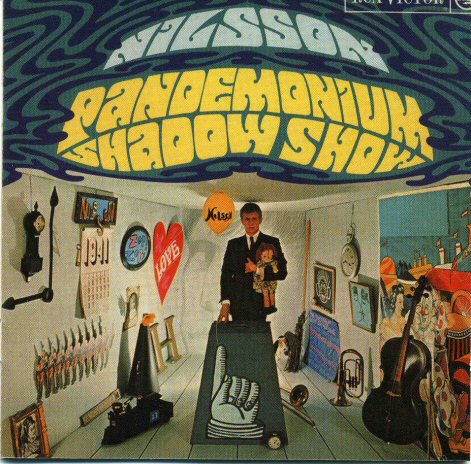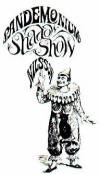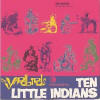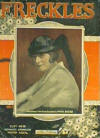![]()
 Pandemonium
Shadow Show
Pandemonium
Shadow Show
![]()
The title is the name of Cooger and Dark's 'circus side-show' from the book ‘Something Wicked This Way Comes’ by Ray Bradbury. Harry had originally wanted 'Something Wicked...' to be the title of the album but RCA was worried about copyright issues, hence the change.
Although the album met with considerable critical success sales were (although respectable for a debut artist) somewhat sluggish. Almost certainly, Harry’s biggest breakthrough came when Derek Taylor, the Beatles publicist and long-term friend and colleague at Apple, discovered the recording. Suitably impressed, not least by the two Lennon/McCartney songs on the LP, he bought a whole box full of copies and took them with him back to London. Taylor said, many years later that it was a ‘stunning album and God only knows how it wasn’t seen by the masses as a mighty work at the time’.
Within a few weeks, when asked by an interviewer who their favourite group was, John and Paul replied ‘Nilsson’. They also rang him (individually) in his RCA office (the office was the 'perk' he asked for after signing a three-year $50,000 contract). From such testimonials are careers made and Harry, of course, became a great friend and frequent collaborator with each of The Beatles over the next decade.
The original release
came in two formats – the single album with colour front cover and black and
white montage rear and a special collectors/promotional pack which contained
a press pack,
biography, information sheet, lyrics for all
the Nilsson compositions, a but ton
(badge), 2 8x10 photographs, a poster, and balloons.
ton
(badge), 2 8x10 photographs, a poster, and balloons.
The picture on the front of the album shows the young Nilsson surrounded by a cornucopia of artifacts, each of which has an association with a song found on the record. I will try to list as many of these as I can (in brackets and in red italics after each song title below - with thanks to Ben Paxton-Crick, another Welsh Nilssonian!)
The overall ‘feel’ of the album is of a circus – or at least a show put on by an artist reluctant to appear as himself and appearing in the guise of a clown, a crooner, a vaudeville comedian…highly appropriate considering that Nilsson was to go through his entire career without performing in concerts or developing any kind of relationship with a live audience. Harry was a studio artist above all, one who both endured and enjoyed his ‘perfectionist tendencies’, an inveterate ‘twiddler’ who would return to the same pieces time and time again, even after they had been released, trying to enhance and improve them.
It is strangely appropriate, then, that the first thing we hear on the record is Harry, as ringmaster, introducing his own album as if it were a live circus show:
“Ladies and Gentlemen…in the centre ring, presenting Nilsson and his Pandemonium Shadow Show” – or at least that was the intention. By turning the sentence into a tongue twister Nilsson immediately gives the whole project a quirky atmosphere, leaving the listener wondering what on earth might come next. Another appropriate pointer for Harry’s future! He also brings a macabre sense of humour to the fore as well as his overwhelming, natural shyness – he seems to be genuinely embarrassed to be presenting himself to an audience at all. (note the ringmaster's megaphone on the cover)
As the ringmaster’s muddled announcement dissolves into his own laughter a heavily reverbed drum leads us into the opening track…
This, the first track on an RCA Nilsson album immediately presents us with an artist not afraid to tread new ground nor be, for want of a better phrase, politically incorrect. Rhymes such as the one on which this song is based are all but banned from nurseries in this ‘enlightened’ day and age – remember, even the word ‘Indians’ is a step down from the original ‘Ten Little Nigger Boys’
What we actually have here is an amalgam of the old Nursery Rhyme and the 10 Commandments (yes, those – Moses and Mt Sinai etc.) As the song progresses each of the Indians falls victim as he fails to live up to a different one of God’s laws. For what it’s worth, here are the details:
Indian 1 - One stood looking at another man's wife/Thou shalt not covet thy neighbour's wife (or commit adultery)
Indian 2 - One took another's goods/Thou shalt not steal
Indian 3 - One told a lie about another's best friend/Thou shalt not bear false witness
Indian 4 - One thought he'd found another way to get to Heaven/Thou shalt have no other gods before me
Indian 5 - One took another's life/Thou shalt not commit murder
Indian 6 - One pulled his mother down/Honour thy father and mother
Indian 7 - One...forgot to say his prayers/Remember the Sabbath Day and keep it Holy
Indian 8 - One took the name of God in vain/ Thou shalt not take the name of the Lord
thy God in vain
- One took the name of God in vain/ Thou shalt not take the name of the Lord
thy God in vain
Indian 9 - One took a liking to a picture of himself/Thou shalt not make graven images
Indian 10 - One...looking for the sun/this is unclear...probably to do with having other gods again - the 10 commandments are actually more like 14 anyway - coveting the neighbour's wife and committing adultery are 2 different commandments - I think this was just a dramatic way for Nilsson to end the song!
This song was, rather surprisingly, covered by British supergroup The Yardbirds and released as a single in 1967.
"During one session, we were recording 'Ten Little Indians,' which was an extremely silly song that featured a truly awful brass arrangement. In fact the whole track sounded terrible. In a desperate attempt to salvage it, I hit upon an idea. I said, 'Look, turn the tape over and employ the echo for the brass on a spare track. Then turn it back over and we'll get the echo preceding the signal.' The result was very interesting - it made the track sound like it was going backwards." - Jimmy Page
1941 (poster on the wall of a 1941 calendar/circus poster (clown) behind the cello)
1941 has gone down in Harryhead folklore as being a semi-autobiographical song. Harry was, of course, born in 1941 (…a happy father had a son) only for his father to leave soon afterwards (…and by 1944 the father walked right out the door).
After that beginning, how much actually relates to ‘truth’ and how much ‘just went to make a groovy song’ is anyone’s guess although the way the story hangs together with the ‘twist in the tail’ is both clever and captivating.
From a musical point of view one of the most notable features in the song is the scat middle section – this itself a trait which was to mark a great deal of Nilsson’s early work. By employing this technique Harry could always ‘join in’ with the band, using his voice as an extra instrument – becoming part of the texture. Try, for a moment, to imagine 1941 WITHOUT the scat – perhaps with a saxophone playing the lead line in the scat section…it’s not the same is it? Such foibles as the scat singing were very much part of what made Harry what he was – and we should be eternally grateful for that!
Instrumentally, the song sits on the basis of a brass ensemble and organ. These two forces feature prominently through the whole album and, indeed the next one as well, for that matter, although ‘organ’ is, for some reason, not listed amongst the battery of instruments listed in the published credits. (In all, 29 players contributed to the record.) The use of strings as an addition to pop groups had grown ever since George Martin backed ‘Yesterday’ with a string quartet; the use of brass was far less widely used up to this point. The Beatles themselves had started to explore the potential of brass in ‘Penny Lane’ (piccolo trumpet) and in various places on the newly released Sergeant Pepper album (Pandemonium Shadow Show was recorded and released within a few months of Sgt. Pepper’s release).
Whether it was this previous brass exploration catching Nilsson’s ear, something inherent in George Tipton's arranging or even Rick Jarrard’s production the brass section underpins Pandemonium Shadow Show’s character in the same way the strings hold together ‘Yesterday’. (1)
This song is probably more famous for the cover version recorded by The Monkees and was a hit in 1967. It has to be said that this song bears another sign of Nilsson’s ‘unwillingness’ to conform to the ideals and expectations of ‘polite society’. It was always said to amuse Harry when Davy Jones was seen on screen staring into the eyes of an ‘oh, so sweet, demure, All-American girl’ as he sang this song. Did Harry alone know that ‘cuddly toy’ was biker slang for a girl who was a willing participant in a ‘gang-bang’? My guess is that he knew all too well but was unable (or unwilling!) to suppress that wicked sense of humour either then, or on many and various occasions in the future!
The track starts with a wonderful ‘doubled’ piano (courtesy of Michael Melvoin and Bob Segarini) – Harry’s reaction to which was both recorded for posterity and left on the finished song. Such technical feats were only possible due to the skills of RCA engineer Dick Bogert who managed to sync-up two 4-track tape machines in order to create a ‘Heath Robinson’ 8-track. (2)
She Sang Hymns Out Of Tune (Kincaid) the yellow balloon, the broom (for brandishing), a sorcerer's room
For many years I wondered what on earth this song was about. The lyrics tell of a lady who “sang hymns out of tune and carried a yellow balloon, who traded her love for a Spanish doubloon and talked to the people who ‘are’”. Whoever she was she has now ‘passed away’ and gone…to the people who ‘are’. Illuminating! All this mystery is wrapped up in an extremely singable tune and rocked by a waltz beat as infectious as any since Strauss.
I only managed to unravel the mysteries a short time ago when the song was nominated as Track of the Week on Nilssonweb, the Internet community founded by Roger Smith which is the www fount of knowledge for all things Nilssonian. Apparently, it is something to do with a witch!
This rather bizarre song once again prominently features a harmonium organ. This instrument always conjures up images for me of somewhere directly between an old Mission Chapel and a full-blown circus arena. Once again The Beatles had discovered it first, using it on ‘We Can Work it Out’ and then again (or something very similar) in ‘Mr. Kite’, where it once again provided a circus atmosphere. Of course, as she sang hymns (presumably in such a chapel) and appeared as track 4 on an album introduced by a ringmaster this is all very appropriate!
When Harry and E.J. Gold were reminiscing about the recording of "She Sang Hymns Out Of Tune", E.J. was recalling the Swiss bell-ringer who they had for the session, complete with lederhosen. Harry laughed and shook his head. "And this was when "Inna Gadda Da Vida" was a hit," he said. But, really, how do you sell these albums to people who missed out on it before?
A wonderful touch comes near the end of the song where Harry starts to sing in the wrong place…rather than start again he continues…and leaves the error there as a quaint ‘joke’. Somehow, it wouldn’t have been the same without it. It is another mark of Nilsson’s instinct for what was just right: turning an accident into a ‘finishing touch’.
You Can’t Do That (Lennon/McCartney) there is a list of Beatles songs on the floor next to the broom. The word 'love' as 'stolen' in the song
This is, almost certainly, the track that would have first caught the attention of The Beatles. A fairly obscure track from the soundtrack album of ‘A Hard Day’s Night’ (1964) is remade and woven into a most elaborate patchwork Beatles pastiche, a colourful collage of sound which makes aural references to over 20 Beatles songs in its intricate construction.
From the opening words of ‘She’s a Woman’ to the closing ‘Strawberry (Fields) Beatles for ever’ we are taken on a whirlwind trip through the catalogue of the Fab Four yet, amidst the stream of quotes, Harry never loses sight of the fact he is performing ONE song, and the background collage enhances, rather than detracts from, the overall performance of it.
One feels inclined to say that this song is entirely unlike every other song on the album…except that the same thing could be said for most of the tracks on the album! This mid-tempo ballad, punctuated with Indian tablas and Harry’s scat, allows Nilsson to sing in the lazy, ‘make the most of every syllable’ style he was to make his own over the next few years.
A composition unlike any other Nilsson had written before is enhanced by George Tipton’s impeccable arrangement, blending strings and brass and with Harry’s scat singing added between lines to create a rich, orchestral texture. The song itself has little metric sense; uneven lines which, in the hands of lesser craftsmen would sound clumsy, ‘Sleep Late’ flows along effortlessly, drifting from lazy, lilting Latin to a slightly more energetic, brassy American sound without the join showing at all.
‘Cielito Lindo’, the song mentioned in the lyrics is a very famous Mexican folk-tune best known in the USA as the “Frito Bandito” melody from that popular advertising campaign.
One of Harry’s most treasured abilities was the way he could take someone else’s songs and make you think they were his. Although many members of the public know little about Nilsson, most who know anything at all seem to realise he was a songwriter. It is almost invariably a surprise to them to learn that Harry did not write ‘Without You’ or ‘Everybody’s Talkin’, his two biggest hits.(3)
This lovely Paul McCartney ballad, telling the story of a frustrated teenage girl who, unable to communicate with her parents, runs away from home to be with her ‘man from the motor trade’ had only appeared on ‘Sgt. Pepper’ a few months before ‘Pandemonium Shadow Show’s release. It was a canny move by Nilsson to include a track from the ‘album of the year’, yet he was innovative enough to give the song a completely different reading. With the aid of Tipton the harp was replaced by a harpsichord and the cello by a euphonium, or baritone horn. This instrument is rarely used in orchestras (where it may be known as a tenor tuba) but is a member of brass and wind marching bands. This was its first appearance on a Nilsson track as a ‘lead’ instrument although it was to be used several times more in future.
These subtle instrumental changes help remove quite a substantial proportion of the ‘pathos’ inherent in McCartney’s own version, giving the song a slightly grittier, more adult edge – a feat Nilsson repeated with the self-penned ‘Mourning Glory Song’ which, like ‘She’s Leaving Home’ led off Side 2 on his next but one album “Harry”. (It is no coincidence that ‘Mourning Glory’ also features the euphonium prominently.)
A song in 5/4 time! Now that’s a rare thing. This jazz number, composed by Perry Botkin jr. and Garfield fits in perfectly between two of the album’s more downbeat numbers – it’s sense of hopefulness and the joys of being in love only to be dashed on the shores of despair by the song which follows it. The brass (particularly trombone) playing on this track is sensational, the best in jazz horn-blowing.
Stylistically, the song rides on the 5/4 rhythm brought to public attention by Dave Brubeck (Take 5) but, in fact, the rhythms of this 'pop' song are far more complex than in the jazz number. The time signature changes very often - but Harry was able to take it all in his stride, once again showing a natural affinity with jazz. Harry's falsetto scat in this song is, in my opinion, the best he ever sang - absolutely superb!
Not many notice the absence of drums from this track - the only percussion is the expertly handled tambourine. This arranging touch alows the other instruments to be heard clearly - I'd LOVE to hear a track only version of this song!
Without Her hands on the clock (telling the lovers to part) - pretty balloon
Undoubtedly, one of the highlights of a great album. The accompaniment is extremely sparse, featuring simply cello, flute, guitar and plucked double bass. Of all the original songs Nilsson had recorded to this point this one showed him at his best as a songwriter completely at home singing his own material. This song featured in the TV programme 'The Ghost and Mrs. Muir' which featured Harry as singer Tim Seagirt. My own cover version of this wonderful song can be heard here.
Screen shots from the
TV show (click to enlarge):


Freckles (Hess, Johnson/Ager) the picture of 'Freckles' is on the wall above the Beatles poster.
 This
is a very old, vaudeville song, originally sung by Nora Bayes and was
originally taught to Harry by his mother and aunt who often sang it to him. It is a
humorous song about a boy who always got the blame for any trouble - no
matter how improbable it might have been for him to be involved! As
Harry as a child had copious freckles it easy to see how this became a
family favourite and why Harry may heave felt so fond of it he chose to
include it on his first 'real' album.
This
is a very old, vaudeville song, originally sung by Nora Bayes and was
originally taught to Harry by his mother and aunt who often sang it to him. It is a
humorous song about a boy who always got the blame for any trouble - no
matter how improbable it might have been for him to be involved! As
Harry as a child had copious freckles it easy to see how this became a
family favourite and why Harry may heave felt so fond of it he chose to
include it on his first 'real' album.
It's Been So Long 'since I kissed you' - see the picture of a kissing couple.
This song, as much as any other shows how much Harry's songwriting had improved in the year or so since the 'Spotlight' album. This is a well-crafted composition which fits in perfectly at this point in the album.
River Deep - Mountain High (Spector/Barry/Greenwich) Harry holds the rag doll and is followed by the puppy
This song had been a hit for Ike & Tina Turner and Harry does the song justice by ending the album with this epic production (in which George Tipton also tips more than a wink to Phil Spector). Harry rocks the socks off this number, his vocal acrobatics and power lifting it to the heights in which many feel this is the best version of the song ever recorded.
And the ringmaster returns to end the whole thing with another slice of quirky humour...he still can't get his announcement right!
BONUS TRACK
As I Wander Lonely (Botkin/Garfield)
This song was recorded on the same day as 'Sleep Late' and composed by the duo who also gave us 'There Will Never Be'. The beautiful 'empty' production of the early verses is illuminated once again by Jesse Erlich's delightful cello then more 'Tipton horns' take over...and all the time Harry's voice, in supreme form lilts the lovely melody and poetic lyrics. Milt Holland, who had played tablas on 'Sleep Late' was obviously 'in the mood' as he added them to this track too. This lovely recording was left off the album and did not surface until the Personal Best collection some 26 years later.
(1) In fact, the use of brass on both this album, it’s successor Aerial Ballet and other recordings of this Nilsson era like ‘Best Friend’ (the theme for the TV show) and the commercial he wrote for Ban Deodorant is a common ingredient in the Nilsson sound. (Best Friend was also recorded as ‘Girlfriend’ but the song remained unreleased until the Personal Best Anthology, which Harry was working on when he died. The TV series starring a young Brandon Cruz ran from 1969 and the theme is amongst the best known American TV favourites. Even more interestingly, Harry and Brandon recorded a new duet version in 1993 which was released as one of the song for Cruz’s 1998 solo album ‘Eddie is a Punk’)
(2) Heath Robinson was an eccentric British inventor in the early 20th Century who designed and made strange, working machines from bits and pieces of other ones. Regarded as something of a ‘mad professor’ his name has come to represent any machine cobbled together from bits.
(3) This very fact, of course, had ultimately tragic consequences for Badfinger’s Pete Ham and Tom Evans, the men who DID write ‘Without You’ but failed to get the recognition they deserved – being at least a contributory factor in their suicides.